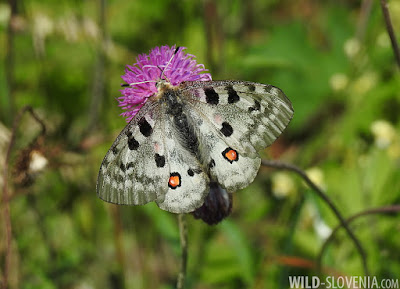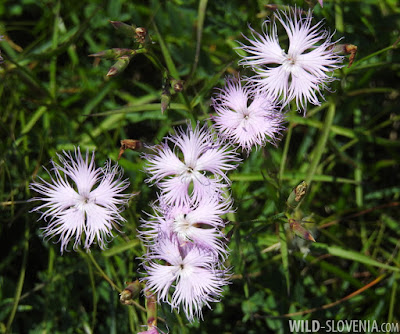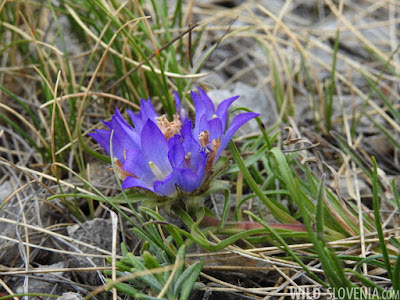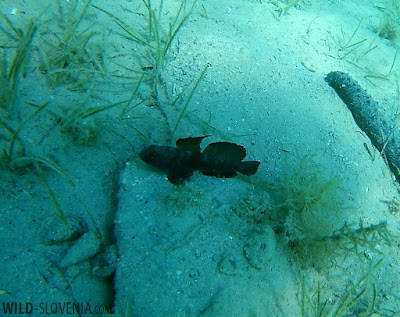
On this blog we don't normally post material from outside Slovenia, but this time we'll make an exception, due to the extremely interesting content of the post. Summer is holiday time, so even at WildSlovenia we sometimes take a "private break" and wander away on a longer trip. This time we visited the central Dalmatian coast in Croatia on a "sea & wildlife trip". Thus we enjoyed the clean and beautiful Croatian sea, as well as some local bird specialities & other wildlife typical of the region. The areas we visited included: the Lake Vrana Nature Park (south of Zadar), the Paklenica National Park (near Starigrad Paklenica), the island of Pag, the Velebit mountains and several other sites in between and on the way home. As usual, below is a selection of photos arranged in a more or less "habitat order", showing both the wildlife and the landscape. Being a truly summer trip, we also enjoyed in snorkeling (on a daily basis) and took some underwater photos with a GoPro. The Adriatic sea is not as rich as the tropics, but still, with a bit of perseverance, one can find some amazing wildlife here too. You'll find some fish photos at the end of the post. Enjoy!


The Velebit mountains dropping down by the Adriatic sea, in the Paklenica National Park. The rocky scrubland is the habitat of an interesting array of birds.
Rock Nuthatch Sitta neumayer, Paklenica National Park.
A common inhabitant of rocky areas; we saw/heard up to 10 in a morning.
Sombre Tit Poecile lugubris, Paklenica National Park.
A quite scarce bird in scrubby areas with oaks on rocky slopes.
We struggled a bit with this species, but at the end we observed a family of 3 individuals.
Rock Partridge Alectoris graeca, Paklenica National Park.
A common species in rocky habitats; at dawn one day we observed a flock of about 8-10, including two juveniles.
Eastern Orphean Warbler Sylvia crassirostris, Paklenica National Park.
Another relatively common species in scrubland areas on stony slopes. We had at least 5 individuals one morning, including 3 singing males.
The Hermit Chazara briseis, Paklenica National Park.
An interesting butterfly of dry rocky habitats in southern Europe. The above individual is feeding on Cephalaria leucantha - an abundant plant in Dalmatia.
Southern Comma Polygonia egea, Paklenica National Park.
Limestone mountains in the Paklenica National Park.
Wall Brown Lasiommata megera & corroded limestone, Paklenica National Park.
Waldstein's Bellflower Campanula waldsteiniana, Paklenica National Park.
An endemic species of rocky cracks in the southern Velebit mountains.
Adriatic Bellflower Campanula fenestrellata, Paklenica National Park.
Another endemic species of central and southern Velebit mountains, commonly found in the Velika and Mala Paklenica canyons.
Pyramidal Bellflower Campanula pyramidalis, Paklenica National Park.
A very common species all along the Adriatic coast of Croatia, but also in Slovenia and NE Italy.
Savory Satureja subspicata, Paklenica National Park.
Southern Globethistle Echinops ritro, Paklenica National Park.
Amethyst Eryngo Eryngium amethystinum, Paklenica National Park.
Like in the dry grasslands of the Karst in Slovenia, this species is very abundant all over the limestone Croatian coast & mountains.
Edraianthus tenuifolius, Velebit mountains near Senj.
A Balkan endemic species of dry grasslands and rocky areas.
The Velebit mountains, Paklenica National Park.
Hoopoe Upupa epops, Paklenica National Park.
View from Paklenica National Park to the Adriatic sea and the large stony island of Pag.
Dry rocky grasslands on the island of Pag. Another habitat for a whole variety of species.
Stone Curlew Burhinus oedicnemus, island of Pag.
The species is very common in certain areas of the island. We saw the above bird, hiding among rocks (can you see it?) and heard several other birds calling repeatedly, especially at dusk.
Rock Partridge Alectoris graeca, island of Pag.
Also here this species is very common and can be seen quite easily, especially around dusk and dawn. We saw at least 5 (and heard some more) one evening.
Tawny Pipit Anthus campestris, island of Pag.
A common bird of dry grasslands.
Short-toed Eagle Circaetus gallicus, island of Pag.
The rocky grasslands are a paradise for reptiles and obviously for their hunters as well.
Yellow Star-thistle Centaurea solstitialis, island of Pag.
Field Eryngo Eryngium campestre, island of Pag.
Common on Pag as it is the Amethyst Eryngo elsewhere.
Drypis spinosa, island of Pag.
Common Golden Thistle Scolymus hispanicus, island of Pag.
Crested Lark Galerida cristata, island of Pag.
A very common species of rocky grasslands. In the same habitat on Pag, Calandra Lark Melanocorypha calandra & Short-toed Lark Calandrella brachydactyla are also found in smaller numbers.
Velo Blato - a large freshwater lake on the island of Pag, where lots of birds gather, especially during migration. Here we saw among others: Pygmy Cormorant Phalacrocorax pygmeus, Little Bittern Ixobrychus minutus and Purple Heron Ardea purpurea.
Glossy Ibis Plegadis falcinellus & Night Heron Nyctocorax nycticorax, Velo Blato (island of Pag).
There was a flock of 17 Glossy Ibises on the lake.
Montagu's Harrier Circus pygargus, island of Pag.
A common breeding species in rough grasslands and fields, both on Pag and on the coast. The most numerous raptor we saw during the trip!
Black Pennant Selysiothemis nigra, island of Pag.
A rare dragonfly confined to some Mediterranean wetlands. Pag is a known site for the species, although we also found one at lake Vrana, on the coast.
Woodchat Shrike Lanius senator, island of Pag.
We saw this species on several occasions, both on Pag and on the mainland, in cultivated areas.
Little Owl Athene noctua, island of Pag.
Common on the island, especially in the shepherds' old buildings and along dry stone walls.
Hermann's Tortoise Testudo hermanni, mainland near the island of Pag.
We helped this tortoise cross a busy road, after we almost run over it. Quite a moment as this was a lifer for us! This species is one of the few native European tortoises. It lives in southern Europe, inhabiting dry bushy areas and meadows.
Lake Vrana and the limestone hills above Vrana village.
Pygmy Cormorant Phalacrocorax pygmeus, lake Vrana.
The lake is home to Croatia's largest breeding population of this south-east European species.
Spanish Sparrow Passer hispaniolensis, lake Vrana.
A very common bird around lake Vrana and in the surrounding framlands. In the evenings we watched huge flocks (500-1000 or more) gather in the lake's reedbeds to roost.
Bee-eater Merops apiaster, lake Vrana.
Another common bird in open areas, usually seen perched on wires.
Turtle Dove Streptopelia turtur, lake Vrana.
This colourful dove is one of the commonest species of bird encountered in Dalmatia. It is frequently seen as an urban bird too.
Tree Grayling Neohipparchia statilinus, lake Vrana.
Southern Gatekeeper Pyronia cecilia, lake Vrana.
Queen of Spain Fritillary Issoria lathonia, lake Vrana.
Great Capricorn Beetle Cerambyx cerdo, Paklenica National Park.
Turkish Gecko Hemidactylus turcicus, Pakoštane.
Snorkeling in the Adriatic sea...
Greater Weever Trachinus draco, Pakoštane.
This species was frequently seen during our dives in different areas along the Dalmatian coast. It is principally known by being one of the most venomous fish in the Mediterranean
(strong venom in its dorsal spines). It is a bottom-dwelling species that usually buries itself into the sand.
Red-black Triplefin Tripterygion tripteronotum, island of Pag.
Peacock Blenny Salaria pavo, island of Pag.
Red Mullet Mullus surmuletus, Pakoštane.
Black Goby Gobius niger, Pakoštane.
Goldline Sarpa salpa, Annular Seabream Diplodus annularis, East Atlantic Peacock Wrasse Symphodus tinca, Ocellated Wrasse Symphodus ocellatus, Pakoštane.
White Seabream Diplodus sargus (left) & Painted Comber Serranus scriba (right), Pakoštane.
Mediterranean Rainbow Wrasse Coris julis, Starigrad.
Spiral Tube-worm Sabella spallanzanii, Pakoštane.
Sunset over the Velebit mountains & the Adriatic sea.



































































































